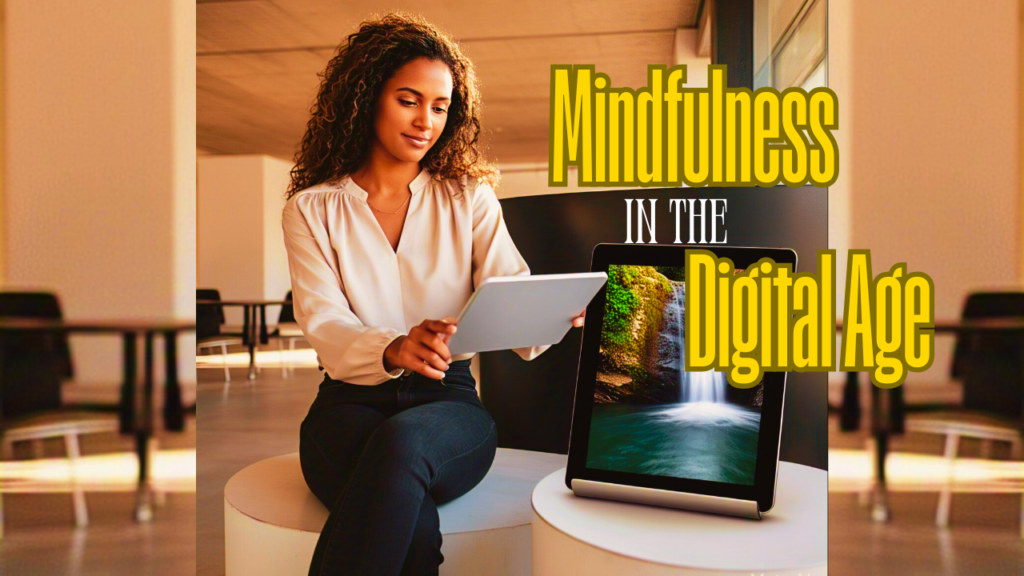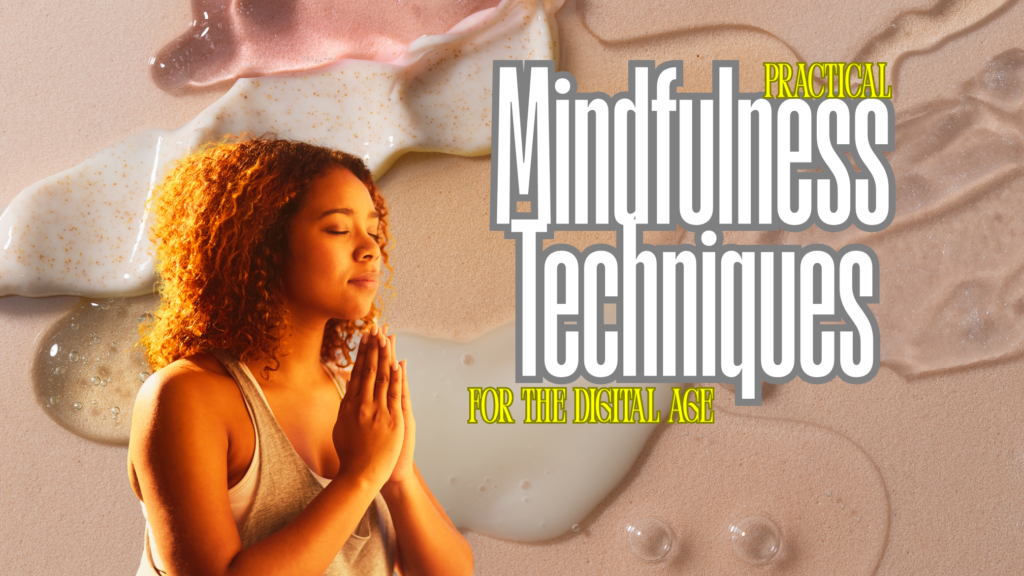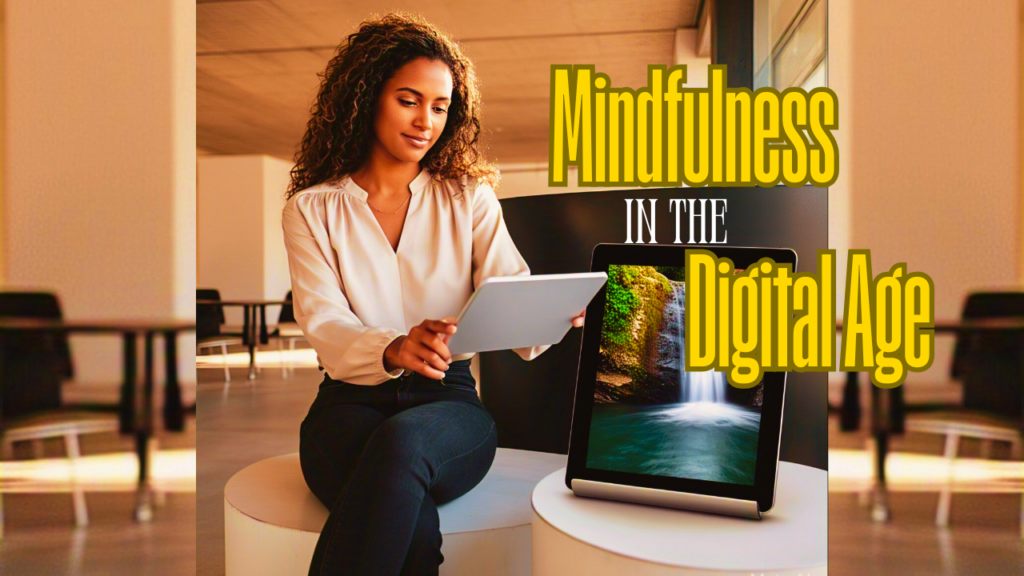
In today’s hyper-connected world, our attention is constantly under siege. Notifications ping, emails flood in, social media feeds endlessly scroll, and the pressure to stay “plugged in” is immense. This constant digital barrage can leave us feeling scattered, stressed, and struggling to concentrate. But what if there was a way to navigate this digital landscape with more intention, calm, and focus? Enter Mindfulness in the Digital Age, a crucial practice for reclaiming our attention and enhancing our overall well-being.
Feeling overwhelmed isn’t just in your head; the constant task-switching and information overload genuinely impact our cognitive function and mental health. The good news is that mindfulness offers practical, accessible tools to counteract these effects. This post explores actionable techniques to enhance focus and well-being amidst the challenges of modern technology.

The Digital Dilemma: Why We’re Losing Focus
It’s no secret that staying focused in today’s digital world feels like an uphill battle. Indeed, we’re constantly bombarded by screens and notifications, and as a result, it’s genuinely affecting our ability to concentrate. Think about it – social media feeds, endless emails, and instant messages seem to have retrained our brains to crave that next hit of information, making deep focus incredibly tough. Consequently, this feeling of being overwhelmed, often termed digital overload, isn’t just in our heads; it leads to real stress, lower productivity, and mental fatigue. However, mindfulness in the digital age offers a real lifeline. By consciously adopting mindful habits like setting intentional screen time, practicing deep breathing, and taking digital breaks, we can take back our focus, boost our well-being, and engage with the online world in a more balanced and aware way.
To really tackle this, let’s break down the key reasons why our focus is under attack:
- Information Overload: We consume more information daily than ever before, overwhelming our brain’s capacity to process it effectively.
- Constant Distractions: Persistent notifications train our brains to be reactive, pulling us away from deep work and meaningful connection.
- The Myth of Multitasking: Trying to do multiple things at once (especially digitally) often leads to reduced efficiency, increased errors, and heightened stress.
- Comparison Culture: Social media can fuel anxiety and feelings of inadequacy through constant comparison.
- Blurred Boundaries: Technology often blurs the lines between work, personal life, and rest, leading to burnout.
- Recognizing these challenges is the first step toward implementing effective strategies for mindfulness in the digital age.

What is Mindfulness and How Can It Help?
At its heart, mindfulness is the practice of paying attention intentionally to the present moment, without judgment. It’s not about silencing your thoughts, but rather observing them, along with your feelings, bodily sensations, and surroundings, without getting swept away.
In our current environment of relentless digital stimulation, cultivating mindfulness in the digital age becomes a powerful tool for regaining command over our attention and mental clarity. For instance, by consciously pausing before reacting to that tempting notification, establishing clear boundaries with our technology use, and actively engaging in deep focus exercises, we can effectively diminish stress and foster a more balanced and healthy relationship with our digital companions.
Specifically, when applied to our digital interactions, mindfulness empowers us to:
- Enhance Self-Awareness: Become more attuned to the triggers that lead us to reach for our phones or mindlessly scroll through feeds.
- Sharpen Concentration: Strengthen our ability to maintain focus on the task at hand, despite digital distractions.
- Decrease Reactivity: Create a buffer between a digital stimulus (like an alert) and our immediate response.
- Alleviate Stress & Anxiety: By anchoring ourselves in the present, we lessen the grip of worries about the past or anxieties about the future, often amplified by digital input.
- Promote Conscious Engagement: Shift from automatic, habitual technology use to making deliberate and intentional choices about how we interact with our devices.

Practical Mindfulness Techniques for the Digital Age
Integrating mindfulness doesn’t require hours of meditation (though that helps!). Here are practical techniques to enhance focus and well-being that you can weave into your daily digital interactions:
The Mindful Tech Check-in
Before unlocking your phone or opening a specific app (especially social media or email), take one conscious breath. Ask yourself: “What is my intention right now? What do I really need to do?” This small pause breaks the cycle of automatic, mindless checking.
Single-Tasking: Reclaim Your Focus
Resist the urge to juggle multiple digital tasks. When working on a document, close unnecessary tabs and apps. When replying to an important email, give it your full attention. Treat each digital task as a singular event. This dramatically improves the quality of your work and reduces mental fatigue.
Taming the Notification Tyranny
Notifications are designed to hijack your attention. Be ruthless:
Turn off non-essential notifications (social media likes, game updates, news alerts).
Schedule specific times to check email or messages rather than reacting instantly.
Use “Do Not Disturb” or “Focus Modes” strategically during work or rest periods.
Create a “Digital Sunset”
Constantly stimulating your brain, especially with blue light from screens before bed, disrupts sleep patterns. Designate a tech-free period (e.g., 30-60 minutes) before sleep. Use this time to read a physical book, listen to calming music, stretch, or simply unwind without screen interference.

Mindful Breathing Breaks (Screen-Free)
Set a reminder to step away from your screen every hour or so. During this short break (even 1-3 minutes), simply focus on your breath. Notice the sensation of air entering and leaving your body. This resets your nervous system and clears mental clutter.
Practice Mindful Consumption
This goes beyond just limiting screen time; it’s about becoming aware of the quality and impact of the digital content you engage with. Much like mindful eating involves noticing the taste, texture, and effect of food on your body, mindful consumption involves paying attention to the information you ‘feed’ your mind. Ask yourself how scrolling through a particular feed or reading certain news actually makes you feel. Is it nourishing your intellect or curiosity, or is it draining your energy or fueling anxiety? Becoming aware of these effects is the first step toward making more intentional choices about your digital diet.
Be intentional about the digital content you consume. Ask yourself:
Is this information truly valuable or just noise?
How does consuming this make me feel (informed, anxious, inspired, drained)?
Am I seeking information or just escaping boredom or difficult feelings?
Choose content that aligns with your values and well-being goals.
Use Technology Mindfully (Yes, Really!)
It might sound counterintuitive, but technology itself can be a tool for cultivating mindfulness if used intentionally. Instead of viewing apps and features solely as sources of distraction, consider how they can support your well-being goals. This involves shifting from passive, reactive use to active, purposeful engagement. Think of your smartphone or computer not just as a portal to endless information but as a device whose functions you control for your benefit.
Use apps and features designed for well-being:
Meditation & Mindfulness Apps: Utilize guided meditations, breathing exercises, or ambient sounds (e.g., Headspace, Calm, Insight Timer).
Focus Timers: Employ techniques like the Pomodoro method using timer apps to structure work and break periods, training your focus.
Screen Time Trackers: Use built-in phone features or apps to simply build awareness of where your digital time goes, without initial judgment.
Digital Wellbeing Features: Explore features like grayscale mode, app limits, or focus modes to consciously reduce stimulation or restrict access during certain times.
Mindful Walking (No Phones Allowed)
When you walk – whether it’s a commute, a break, or exercise – try leaving your phone behind or keeping it securely pocketed. Pay attention to the physical sensations: your feet hitting the ground, the air on your skin, the sounds around you. It’s a simple yet powerful way to reconnect with the present moment.

To effectively navigate the demands of the digital age, incorporating specific mindfulness practices into our daily routines is key. Here are several actionable techniques you can implement:
Cultivating a Mindful Mindset in a Digital World
The practical techniques we’ve explored are valuable starting points for bringing mindfulness into your digital life. However, truly integrating mindfulness in the digital age and experiencing lasting benefits requires more than just occasional practice. It involves cultivating an ongoing mindful mindset – a way of approaching your interactions with technology with intention and awareness. This foundational mindset rests on these key principles:
- Patience: Building lasting change takes time. Developing new habits and retraining your attention take consistent effort. Be patient and understanding with yourself as you navigate the inevitable distractions and build your capacity for focused attention. Remember that progress is often gradual.
- Consistency: Small, regular efforts matter most. Integrating mindfulness isn’t about grand gestures but about consistently applying small techniques in your daily digital interactions. Aim to incorporate one or two practices regularly rather than trying to overhaul everything at once. These consistent efforts will compound over time, leading to significant improvements.
- Self-Compassion: Expect distractions, respond gently. In our digitally saturated world, getting distracted is a common experience. When you notice your attention wandering, resist the urge to criticize yourself. Instead, acknowledge the distraction with kindness and gently redirect your focus back in your intention. This self-compassionate approach fosters a more sustainable practice.
By consciously embracing and applying theseprinciples of patience, consistency, and self-compassion, you move beyond simply using mindfulness techniques, You begin to cultivate a fundamental shift in your relationship with technology-moving from a place of reactivity and being controlled to one of intentionality and using technology as a tool that genuinely serves your goals and overall well-being in the digital age.

Frequently Asked Questions
Q1: What’s the difference between mindfulness and meditation? A: Meditation is often a formal practice (like sitting and focusing on the breath) used to cultivate mindfulness. Mindfulness is the broader quality of awareness that you can practice anytime, anywhere – including during daily activities like checking email or walking, not just during formal meditation.
Q2: How long until I notice the benefits of these techniques? A: Some benefits, like a moment of calm after a mindful breath, can be immediate. Others, like improved focus or reduced reactivity, build gradually with consistent practice over days and weeks. Patience is key.
Q3: Can I practice mindfulness while using social media? A: Yes! It involves bringing awareness to the experience. Notice your intention before opening the app, pay attention to your feelings as you scroll (boredom, envy, connection?), observe the urge to keep scrolling, and make a conscious choice about when to stop.
Q4: Do I need to do a full “digital detox” to be mindful? A: Not necessarily. While periodic detoxes can be beneficial for some, mindfulness is more about changing your relationship with technology during everyday use. Small, consistent mindful practices can be just as impactful as infrequent total breaks.
Q5: I feel overwhelmed just thinking about this. Where do I start? A: Start small and simple. Pick just one technique that resonates most – perhaps the “Mindful Tech Check-in” or turning off non-essential notifications. Practice only that for a week. Don’t try to do everything at once.

Conclusion: Your Focus and Well-being Matter
Navigating the complexities of modern life requires new skills. Mindfulness in the Digital Age isn’t about rejecting technology but about developing a healthier, more intentional relationship with it.
In conclusion, thriving in our intricate modern world demands a new set of skills. Mindfulness in the digital age isn’t about shunning technology but rather about cultivating a more balanced, healthier, and intentional connection with it. By embracing the practical techniques outlined in this guide, and by considering the answers to common questions, you can effectively mitigate digital overwhelm, sharpen your concentration, alleviate stress, and ultimately cultivate a more present, focused, and fulfilling life in our digitally driven society. Take that first step today. Select one technique that speaks to you and commit to practicing it consistently this week. Pay attention to the positive changes you experience. Reclaiming your attention and well-being in the digital age is not only possible – it’s within your reach, one mindful moment at a time.

Further Resources
If you’d like to explore mindfulness and digital well-being further, here are a few resources (these are examples, not exhaustive endorsements):
Apps:
- Headspace: Guided meditations, focus exercises, sleep sounds.
- Calm: Meditations, sleep stories, mindful movement.
- Insight Timer: Large library of free guided meditations from various teachers.
- Forest: An app that helps you stay focused by growing a virtual tree when you leave your phone alone.
Books:
- “Mindfulness: An Eight-Week Plan for Finding Peace in a Frantic World” by Mark Williams and Danny Penman.
- “Digital Minimalism: Choosing a Focused Life in a Noisy World” by Cal Newport.
- “Wherever You Go, There You Are” by Jon Kabat-Zinn.
Websites:
- Mindful.org: Articles, resources, and information on mindfulness practices.
- Center for Humane Technology: Insights into ethical technology design and its impact on well-being.